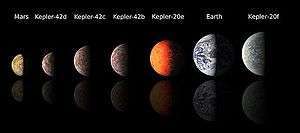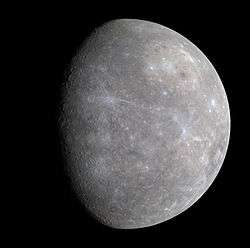Sub-Earth
A sub-Earth is a planet "substantially less massive" than Earth and Venus.[1] In the Solar System, this category includes Mercury and Mars. Sub-Earth exoplanets are among the most difficult type to detect because their small sizes and masses produce the weakest signal. Despite the difficulty, one of the first exoplanets found was a sub-Earth around a millisecond pulsar PSR B1257+12.
Space observatory Kepler opened the realm of sub-Earths by discovering them. On January 10, 2012, Kepler discovered the first three sub-Earths around an ordinary star, Kepler-42. As of June 2014, Kepler has 45 confirmed planets that are smaller than Earth, with 17 of them being smaller than 0.8 Rⴲ. In addition, there are over 310 planet candidates with an estimated radius of <1Rⴲ, with 135 of them being smaller than 0.8 Rⴲ.[1][2]
Sub-Earths commonly lack substantial atmospheres because of their low gravity and weak magnetic fields, allowing stellar radiation to wear away their atmospheres.[1] Due to their small sizes, and unless there are significant tidal forces when orbiting close to the parent star, sub-Earths also have short periods of geologic activity.
References
- 1 2 3 Sinukoff, E.; Fulton, B.; Scuderi, L.; Gaidos, E. (2013-08-28). "Below One Earth Mass: The Detection, Formation, and Properties of Subterrestrial Worlds". arXiv:1308.6308
 [astro-ph.EP].
[astro-ph.EP]. - ↑ NASA Exoplanet Archive

